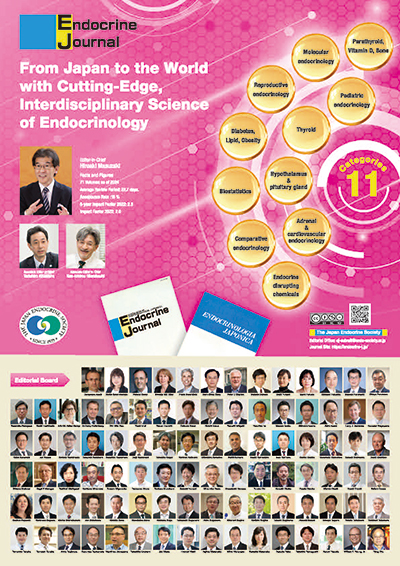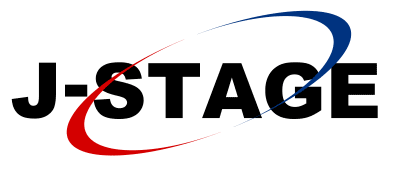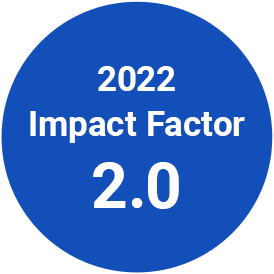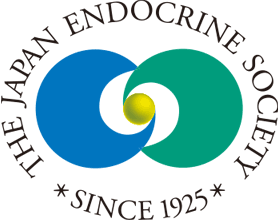[Print version] Ethics Policies
The Editorial Board of the ENDOCRINE JOURNAL (EJ) follows the recommended procedures outlined by the Committee on Publication Ethics (COPE) International Standards for responsible research publication for authors and editors when dealing with allegations of misconduct.
All authors are fully responsible for the originality and contents of their submitted manuscripts. All records and data presented in the manuscripts must be accurate, without any research misconduct such as fabrication, falsification, plagiarism, or any other research or publication misconduct.
Any identified misconduct is subject to investigation by the Editorial Board of EJ. All misconduct and breach of publication ethics, irrespective of the extent thereof, may result in retraction, publication of formal notice of the misconduct, and formal embargo on future contribution to EJ.
I. Definitions of Publication Misconduct
Fabrication
Fabrication is inventing data or results of research and recording or reporting them with the intentional purpose of deception.
Falsification
Falsification is defined as an inaccurate presentation of research results with the intention to give a false impression. This includes manipulation of research instrumentation, materials, and processes, changing, adding or omitting data, manipulating images, and omitting research results.
Scientific images for publication must be minimally processed. We understand that some image processing may be necessary. Adjustments, such as in brightness, contrast, or color, are permissible as long as these adjustments are applied to an entire image uniformly and do not selectively enhance, eliminate, or mispresent any elements in the original image, including the background.
Plagiarism
Plagiarism is defined as the use of another person’s ideas, processes, results, words, or theories as if they were the author’s own, without giving appropriate credit. This involves any part of the manuscript, including the figures and tables. All information and content that originate from other resources must be credited and cited and included in the “References” section. Upon submission, the manuscript will be automatically checked for plagiarism by using plagiarism screening services or software to determine both text overlap and manuscript originality.
Redundant or Duplicate Publication
Articles that are being considered for publication in another journal, including advanced publications such as “in-press” or “E-pub ahead of print” articles, in any language, will be regarded as redundant or duplicate publication.
EJ does not consider the deposition of manuscripts to not-for-profit preprint servers, such as bioRxiv and medRxiv, before submission to the EJ to be redundant or duplicate publication. Authors who post their manuscripts on a preprint server should disclose the details of preprint posting, including server name, URL link, and DOI, upon submission of the manuscript in the Cover Letter and after Disclosure section of the manuscript.
The author should notify the editor formally about all submissions, postings, and previous reports that could be regarded as redundant or duplicate publication of the same or similar work when submitting a manuscript. Any such material must be referred to and referenced in the submitted work. Copies of such work should be included with the submission. Abstracts or posters presented at scientific meetings are not considered previously published work.
Editorial actions should be expected if redundant or duplicate publication is attempted or occurs without such notification. Editorial actions may include the following: immediate rejection of the submitted manuscript, retraction of published work, a published notice of violation, and revocation of publishing privileges in the journal.
Author’s Undisclosed Conflict of Interest (COI)
According to the ICMJE Recommendations, a conflict of interest (COI) exists “when professional judgment concerning a primary interest (such as patients’ welfare or the validity of research) may be influenced by a secondary interest (such as financial gain).”
A statement regarding COI and related announcements should be included in the “Disclosure” section. If there is nothing to disclose, a sentence such as “None of the authors have any potential conflicts of interest associated with this research” should be added in the “Disclosure” section.
COI should be reported using the COI Form 2 in the submission system. Form 2 should be converted into a PDF file and uploaded with COI form selected as File Designation. COI Forms will be securely managed in accordance with the procedures of EJ Editorial Office.
Citation Manipulation
Citation manipulation, such as inclusion of references from other publications without actually reading the cited work, or self-citing works that are irrelevant, must be avoided.
Copyright Infringement
All information and contents that originate from other resources must be all credited and cited. If any copyrighted or previously published materials, adapted, edited, or otherwise, are used in the manuscript, the author must obtain permission from the copyright owner(s) prior to submitting the paper for review. Also, the authors must cite the source and indicate that permission has been received, as required by the copyright owner(s).
Failure to Obtain IRB Approval
Clinical research included in articles, which report on human subjects or materials of human origin, must comply with the provisions of the Declaration of Helsinki, and it must be mentioned that the study has been approved by the relevant institutional or national review board (IRB). If no approval from any IRB was required, that must be explicitly stated in the manuscript.
Improper Authorship/Contributorship
All authors listed in the manuscript must meet the following criteria of contribution as described by the ICMJE in the Recommendations for the Conduct, Reporting, Editing, and Publication of Scholarly work in Medical Journals.
- Substantial contributions to the conception or design of the work;or the acquisition, analysis, or interpretation of data for the work; AND
- Drafting the work or reviewing it critically for important intellectual content; AND
- Final approval of the version to be published; AND
- Agreement to be accountable for all aspects of the work in ensuring that questions related to the accuracy or integrity of any part of the work are appropriately investigated and resolved.
Exclusion of authors who made a definite contribution or inclusion of individuals as authors who have not made a definite contribution to the work is not permitted. Consent to submit to EJ must be obtained explicitly from all authors prior to submitting a manuscript.
Noncompliance with Local Laws and Regulations
Authors must comply with local regulations and laws if the work involves animals or human subjects, or if it involves investigational drugs, recombinant products, new devices, or any chemical materials that may be hazardous in their use.
Salami-Slicing
So-called “salami-slicing” or dividing a single study into several parts to increase the quantity of submissions to other journals or the same journal is not permitted.
II. Handling Allegations of Misconduct
EJ follows the COPE’s Core Practices guidelines and flowcharts for handling allegations of publishing misconduct pre- and post-publication. For any information that is not mentioned in the COPE guidelines, please refer to COPE’s flowcharts.
Procedure for Handling Allegations of Misconduct in Submitted Manuscripts
When editors, reviewers, authors, and/or journal staff suspect any instances of ethical misconduct during peer review, they should bring them to the attention of the Editor-in-Chief (EIC). The manuscript will be placed on hold. The EIC will review the case and make the preliminary assessment. If the EIC finds that an explanation from the authors is necessary, the EIC will send the corresponding author a notification, which points out the allegation and requests an explanation.
If the corresponding author does not respond and/or provide sufficient rationale for the raised concern, or if the EIC is presented with evidence that establishes the ethical breach, regardless of the severity, the EIC will refer the case to the Editorial Board, which, in turn, will discuss the allegations, explanations, evidence, possible sanctions, and corrective actions, such as publishing an erratum, expression of concern, or retraction.
Possible sanctions may include:
- Official warning to the author
- Immediate rejection of the manuscript
- Publication of formal notice of misconduct
- Formal notice to the author’s institution
- Formal embargo on future contributions to EJ
The authors will be notified of the Editorial Board’s decision. The authors may appeal the decision by sending an appeal letter to the Editorial Board.
Complaints and Appeals
The peer review decisions made based on the editors’ judgment will not be rescinded once they are made. EJ will not reconsider the paper for peer review unless misconduct, negligence, or absolutely unusual pattern of review process by our editorial team is found. EJ, however, considers complaints an opportunity to improve our peer review process, manuscript handling procedures, and management for journal publishing. All received complaints are dealt with constructively and in a timely manner. For procedures not summarized below, please refer to the COPE’s Core Practices in dealing with complains and appeals.
Making a Complaint
To submit a complaint about the policies, procedures, or actions of the journal staff of EJ, please send an e-mail to ej-submit@endo-society.or.jp.
For all allegations of misconduct related to fabrication, falsification, plagiarism, copyright or intellectual property infringement, breach of research ethics, authorship or contributorship disputes, conflicts of interest, or any other problematic conduct either pre- or post-publication, please submit a letter of complaint by e-mail to ej-submit@endo-society.or.jp. The letter of complaint should include factual information and related evidence.
Process for Dealing with Complaints
Once a letter of complaint is received, an e-mail confirming its receipt will be sent to the complainant within three (3) business days (Japan Standard Time), with the assurance that appropriate action will be taken immediately.
The received complaint will be reported to the EIC, who will refer it to the editors and other officials that are relevant to the issue. In a case of a publication ethics violation, the allegations will be investigated, and the necessary decisions will be made in accordance with the COPE’s guidelines and flowcharts. The result of the investigation will be determined within four (4) weeks, if possible. If this is not possible, the complainant will be sent details concerning progress of the investigation until the issue is resolved.
Post-publication Discussions
If readers have a grievance concerning any articles published, they can begin a post-publication discussion by submitting a Letter to the Editor. The EIC (and the editor) will review the letter and may ask other experts in the field to review the content. If appropriate, the editor will ask the authors of the original article to comment and publish both the original letter followed by the author(s) response.
Appeals for Editorial Decisions
Editors of EJ apply their best efforts to provide fair and unbiased reviews and decisions. However, if an author strongly feels that an inappropriate decision has been made by the editors, EJ allows a single appeal of the manuscript’s editorial decision. An appeal should include the detailed information and the clear reasons for the appeal, and it should be e-mailed to ej-submit@endo-society.or.jp.
All received complaints will be forwarded to the EIC, who will then refer them to the editor who handled the manuscript, or the Editorial Board, and they will review the appeal and determine whether any changes to the decision should be made. This may require re-review of the manuscript. The new decision made after the appeal is considered final.
III. Errata, Expressions of Concern, and Retractions
In order to ensure that retractions, errata, and expressions of concern are handled according to industry best practice, EJ follows the Retraction Guidelines, provided by COPE, including:
Errata
An erratum may be issued to notify readers of important errors such as spelling, data, terms, typography, or omission, which occurred during the production process of an accepted article, which may mislead the readers. An erratum is also issued for the correction of author and contributor information.
Expressions of Concern
An expression of concern will be issued if the investigation of an issue concerning a published article raises suspicion but does not provide conclusive evidence, and yet if the EIC feels the article contains invalid results or has strong concerns that readers should be made aware of potentially misleading information contained in the article. Also, an expression of concern may be issued if the investigation requires a considerable amount of time to reach a resolution.
Retractions
EJ adopts the following retraction process:
- Instances requiring an investigation are brought to the attention of the EIC.
- The EIC investigates the case following the step-by-step guidelines provided in the COPE flowcharts. The EIC may contact the authors to request an explanation, which will be evaluated.
- The final decision as to whether to retract is then communicated to the author and, if necessary, any other relevant bodies, such as the author’s institution.
- The retraction statement is then posted online and published in the next available issue of the journal.
EJ may issue retractions to alert the readers of seriously erroneous data that invalidate the conclusion of the study presented in the published article or of ethical misconduct. Retractions are published if the EIC has convincing evidence for the following cases, either as a result of ethical violations or honest error:
- The findings or data are unreliable or misleading
- Plagiarism
- Duplicate publication without permission
- Unethical research
The retraction will include:
- Information of the retracted article, such as title and authors
- Link to the retracted article
- Reasons for retraction
To preserve the integrity of the published record, EJ will not remove the retracted article. It will be maintained on the platform. The PDF will be replaced with a version watermarked with the word “Retracted,” but the original text will remain accessible. A retraction notice will also be published in the next available issue.








